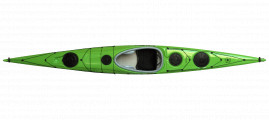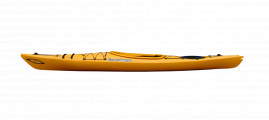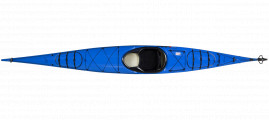Current Designs kayaks emerged from the wilderness of Vancouver Island in the late 1970s with stable, high-storage sea kayaks suited for multi-day coastal travel. Evolutions of these early Current Designs kayaks include the Solstice and Equinox, two classic designs that are still available today.
Over the last four decades, the company has expanded from their coastal touring roots to produce kayaks for everyone, including durable recreational boats and lightweight transitional kayaks for cottage cruising, sleek Danish-style kayaks for ocean play, traditional Greenland-style kayaks for rolling, and more. Current Designs offers a full line of lightweight composite kayaks, as well as ultra-durable rotomolded plastic designs.
If you’re looking for an impeccably finished, thoughtfully designed single or tandem touring, recreational or transitional kayak, there’s likely a Current Designs that’s a great match for you.
In this guide, you will find links to the best Current Designs kayaks on the market, as well as an overview of the types of kayaks this company produces. We’ve also included some buying advice for used Current Designs kayaks and answers to common questions.
Top picks: Best Current Designs kayaks for 2024
The following Current Designs kayaks have received the highest star ratings by reviewers in our Paddling Buyer’s Guide. See and review all Current Designs kayaks here.
Best Current Designs Kayaks
Shop Current Designs kayaks
Browse our Paddling Buyer’s Guide for all the essential details on every Current Designs kayak on the market. Here, you will find specifications, prices, reviews and where to buy Current Designs kayaks.
Use this information to help guide your search, comparing the type of paddling described in the reviews to what you are hoping to do. Follow the links below to filter the kayaks by type.
Shopping for a used Current Designs kayak?
Current Designs’ timeless designs and robust construction make shopping for a used Current Designs kayak a great option. But with outdoor recreation booming, and delays in supply chains impacting kayak availability, where can you find a used Current Designs kayak? Or any kayak, for that matter?
It may take a bit of patience and perseverance to find the right one, but through online classifieds like Kijiji or Craigslist, Current Designs kayaks can be found. Sea kayaks are a niche item, and looking on special-interest pages or Facebook groups, such as a regional paddling club, may quicken the search. These dedicated groups are frequented by avid paddlers, so the kayaks will likely be in better condition.
When looking for a Current Designs kayak, Kijiji searches will be most effective if you try various terms. Beyond the model you are looking for, try more generic ones like “sea kayak” or “Current Designs touring kayak”. Search in all categories, rather than specifically recreation, as sometimes kayaks are listed under “boats”.
Searching for retired demos or rentals is another way to get your hands on a used Current Designs kayak. If an outfitter near you rents Current Designs kayaks, chances are they will be replenishing their fleet as the kayaks get older—ask if they are planning to do so at the end of the season. Renting a boat is also a great way to test how it fits and performs.
With such a long history in the sea kayak world, many Current Designs models are no longer in production. If it is an older kayak or the decals have been removed, the owner may not know the model name. It may take a bit of Internet sleuthing to identify and get more information about the boat.
Happily, the company’s website contains archived pages with descriptions of every Current Designs kayak ever made. Contacting Current Designs with the registration number on the inside of the hull will also provide a definitive I.D. and age of the kayak.
Another benefit of buying an established brand like Current Designs is the ability to source replacement parts. If you find a used Current Designs kayak that needs replacement parts, contact the company. They may have the part in stock or recommend compatible parts to use in the damaged ones’ place.
There’s no real downside to buying an older kayak that has been well cared for. I’ve seen 20-year-old Current Designs kayaks that look brand new because they’ve been stored carefully and never dragged up a beach. Fiberglass boats seem to better stand the test of time, but plastic kayaks that are stored indoors can be an equally good buy.
Proper storage is crucial; UV rays cause devastating damage to kayaks. Garage or indoor storage is best, ideally climate-controlled to negate seasonal temperature fluctuations and prevent moisture. When looking at a used kayak, check inside the hatches and cockpit where moisture may have collected. A well-stored kayak will not have any mildew or dampness inside the hatches. This may not be a dealbreaker if you are considering buying a used kayak, but be prepared to use some elbow grease cleaning it.
When looking at a used plastic kayak, also check the bottom (hull) of the kayak for “oil-canning”—wavy dents that indicate a sun-damaged kayak; these deformities reduce the kayak’s paddling efficiency and performance.
Establishing a fair price for a used kayak is tricky. If stored correctly and well-cared for, a kayak will hold much of its value (this is especially true of hard-to-find, discontinued models). With the pandemic paddlesports boom putting used kayaks in such short supply, quality used kayaks are a rare find.
If you find a perfect fit, don’t hesitate or haggle hard to save a few bucks. This is a long-term investment, and the savings of buying used are likely already significant.
For more tips on what to look for when selecting a used kayak, read our article How To Buy A Used Kayak.
Current Designs kayaks buying advice
Current Designs kayaks meet a range of needs for paddlers of all sizes. Kayaks are a very specialized craft, with deliberate design tweaks for different intended uses. A kayak designed for multi-day camping trips on open water will have different features and performance attributes than a recreational kayak intended for beginner paddlers and short tours on sheltered waters.
Understanding what kind of kayaking you want to do, and where you want to do it, will help you choose the best kayak for your paddling aspirations.
The Current Designs lineup is divided into five categories: Recreational, Transitional, North American-style touring, British-style touring and Danish-style touring.
Kayak styles
Recreational
Current Designs recreational kayaks are perfect for beginners and shorter trips on slow-moving rivers, small lakes and other sheltered waters where nimble handling wins over speed and storage capacity. These stable kayaks range between 10 and 14 feet. They have spacious cockpits for easy entry and exit. While they may resemble kayaks you would see at a big box store or on Amazon, Current Designs’ kayak-building expertise means that their recreational kayaks have better performance and safety than a generic budget kayak.
Popular Current Designs recreational kayaks like the Kestrel and Solara feature two watertight bulkheads (one in the bow, one behind the seat)—a critical safety feature that ensures the kayak will float if it swamps in deep water.
Transitional
Transitional kayaks in Current Designs’ lineup bridge the gap between recreational and touring kayaks. These boats fit in the popular “day touring” category, borrowing elements from dedicated touring kayaks, packaged in the size of recreational kayaks. The flagship Vision series is available in five different sizes and a tandem model to suit paddlers of every size.
Current Designs transitional kayaks have the premium outfitting you would expect on a sea kayak—like decklines, bungees for storage, optional skeg or rudder, and watertight hatches and bulkheads—but they are much shorter. Sized from 12 to 15 feet, they favor stability on calm waters and easy turning over speed. The cockpits are smaller than the Recreational series, adding thigh braces for more efficient paddling and control. Transitional kayaks are best suited for day touring and have storage capacity for shorter overnight trips.
North American-style touring
North American-style touring kayaks are direct descendants of the first boats that Current Designs made. Two of those early designs, the Solstice and the Equinox remain popular today. Other models include the Squall (a plastic version of the Equinox) and two tandems: the Unity and the Libra XT. These kayaks are designed for extended trips in coastal waters; they are high-capacity and comfortable for long days in the seat. North American-style kayaks are more forgiving than both the British and Danish styles.
New paddlers will find these kayaks easier to become accustomed to. They are more efficient, faster and have better tracking (making them easier to paddle straight) than Recreational or Transitional models. North American-style kayaks have foot controlled rudders for added maneuverability and tracking.
British-style touring
Current Designs’ British-style touring kayaks are designed to handle the rough, windy waters common to the British Isles. They are more sleek and lower volume than North American-style touring boats, with narrow, upturned bows to cut through waves. The low-profile, backband seating makes it easier for experienced paddlers to perform a roll in these boats.
Likewise, the shallow “V” hulls and rounded chines (where the sides of the kayak meet the bottom) provide stability in rough waters but will feel less stable than North American-style or Transitional kayaks for beginner paddlers. Check out the Sirocco and Squamish, two of Current Designs’ British-style touring kayaks.
Danish-style touring
The newest category to emerge from Current Designs, Danish-style touring kayaks are the brainchild of esteemed Danish kayak designer, Jesper Kromann-Andersen. These boats have far more rocker (the amount of upsweep from the center of the kayak to its ends) than all of the other kayaks in the Current Designs fleet, making them supremely maneuverable and rough-water capable in the hands of more experienced paddlers.
Under other brands, these may be categorized as “Ocean Play” kayaks, great for surfing, rolling and rough water. The 15- to 17-foot length and efficient hull shapes mean Danish-style kayaks are also well-suited to day or multi-day touring. Snug-fitting cockpits and lively handling make these kayaks best suited to intermediate and advanced paddlers.
Fiberglass or Aramid construction keeps these kayaks lightweight, and priced at the high end of Current Designs’ lineup. The Karla, Prana and Sisu fall within the Danish-style touring category, along with each kayak’s low-volume (LV) editions.
Material
After settling on a style and model of kayak, what material should you go for? Sometimes the choice is made for you, and the kayak is only available in a select build. Other times, you’ll have to weigh the options. As with any kayak, the lighter the layup, the higher the price.
Rotomolded plastic
Rotomolded plastic kayaks are less expensive, heavier and generally more durable—they can take a beating, but it is challenging to fix them should you manage to damage the hull.
Fiberglass
Fiberglass kayaks are much stiffer than plastic boats. This rigidity makes the kayak faster and more responsive. Fiberglass kayaks cannot handle as much abuse as a rotomolded plastic kayak, but they are far from fragile, especially Current Designs’ “heavy water” reinforced layup.
Repairs are also straightforward; if you’re not confident tackling a repair yourself, it’s relatively easy to find a professional who can make the fix. Finally, fiberglass is more expensive, but the boats are lighter than plastic ones.
Aramid composites
Aramid composites are the “ultralights” of the kayak world. These boats land at a higher price point than fiberglass, but you are paying for significantly less weight. These boats are ideal for someone who wants a lightweight kayak that is easier to load on and off a vehicle or carry to the launch.
If you are hard on your equipment, more delicate Aramid construction may not be the best choice.
Finally, remember that online research will only get you so far. If you can, always test paddle before buying any boat. Still wondering if Current Designs kayaks are right for you? Here are answers to some of the most common online questions about Current Designs kayaks.
-
Where are Current Designs kayaks made?
Current Designs kayaks are made in the USA by Wenonah. Their manufacturing facility is located in Winona, Minnesota.
-
Current Designs dealers
Current Designs kayaks are widely available across North America at specialty outdoor and paddlesports shops. Use Current Designs’ dealer locator tool to find a local retailer near you. The page also lists outfitters that offer rentals where you can try before you buy.
-
Current Designs kayak prices
Find manufacturer’s suggested retail prices (MSRP) of Current Designs kayaks on their website. Shipping, optional outfitting and construction layup will affect the costs of the kayaks, and it is best to visit your local paddle shop to get the most up-to-date prices.
For recreational kayaks, expect to spend around $1,000 for a plastic kayak or nearly $2,000 for an ultralight rec kayak; transitional kayaks range from $1,350 to $3,000; and touring kayaks cost between $1,600 and $4,400 (all prices USD).
Compare Current Designs kayaks
-
Current Designs vs Wilderness Systems
Wilderness Systems is another widely-known North American kayak company. They now exclusively make polyethylene boats, although some discontinued fiberglass touring kayaks can be found used. Wilderness Systems makes recreational, day touring, touring and fishing kayaks, including sit-on-top models equipped with pedal drives. Wilderness Systems’ flagship touring kayak, the Tempest, is a British-style kayak, comparable to the Current Designs Sirocco.
Current Designs focuses on sit-inside touring kayaks. Even their recreational models have many elements of a touring boat, like two bulkheads and a skeg or rudder. Current Designs also offers more high-end material options, including fiberglass and Aramid composites. Choose Current Designs for the greatest selection of touring designs and materials; if you are looking for a beginner-friendly sit-on-top or fishing-focused design, Wilderness Systems is the obvious choice.
-
Current Designs vs Eddyline
Based in Washington state, Eddyline specializes in recreational, fishing and day touring kayaks made from thermoformed plastic—a material that has the durability of traditional rotomolded plastic without the heavy weight. Thermoform kayaks are not as light as Current Designs’ Aramid blends, but are still easy to handle. Current Designs offers more touring designs in the 15- to 17-foot range, aimed at paddlers of all sizes and experience levels.
Current Designs’ selection of rotomolded plastic and composite kayaks make for a more comprehensive price range, with some boats more expensive than Eddyline kayaks and some cheaper. If you’re seeking a good variety of lightweight sit-on-top and sit-inside recreational kayaks, or a dedicated fishing kayak, look to Eddyline. If you want a wider selection of full-size touring kayaks, choose Current Designs.
-
Impex vs Current Designs
Now produced by Canadian kayak and canoe manufacturer Abitibi & Co., Impex sea kayaks are high-end, high-performance composite boats. The Impex Force series is known for speedy, rough-water capable hulls. All Impex kayaks are constructed using Kevlar fusion materials, compared to Current Designs’ range of materials.
Current Designs offers more options for beginner and casual paddlers with their recreational and transitional (day touring) models, as well as options for rudder or skeg steering systems. Impex sea kayaks are more suitable for intermediate and advanced paddlers, and exclusively use skegs.
Current Designs kayak reviews
Paddling Magazine is your best online resource for Current Designs kayak reviews. Reading reviews of Current Designs kayaks helps to understand where these boats excel. See what someone else loved about the kayak, and let it guide your decision. When you find one that matches your needs perfectly, remember, it’s always best to “try before you buy.”
- Boat Review: Solstice GT Titan by Current Designs
- Boat Review: Current Designs Ignite Kayak
- Boat Review: Current Designs Squall GTS Kayak
- Boat Review: Prana by Current Designs
- Touring Kayak Review: Current Designs Equinox GT
- Expedition Kayak Review: Current Designs Infinity
- Sea Kayak Review: Current Designs Rumour
- Touring Kayak Review: Current Designs Stratus 18
Feature photo: Courtesy Current Designs













